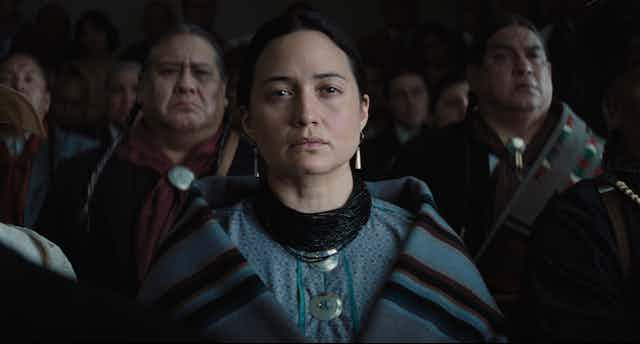Killers of the Flower Moon is an unsettling and powerful historical epic. For her quiet but captivating performance as Mollie Burkhart, Lily Gladstone has rightly been nominated for best actress at the Academy Awards – making her the first Native American woman to compete in this category.
Gladstone has already won both the Golden Globe and Screen Actors Guild award for best female actor. In her acceptance speech at the Golden Globes, Gladstone made it very clear that her success is to be shared with all Native Americans. She opened by introducing herself in her Blackfeet language, before declaring:
This is an historic win. This is for every little rez [reservation] kid, every little urban kid, every little Native kid out there who has a dream, who is seeing themselves represented and our stories told — by ourselves, in our own words.
Killers of the Flower Moon, which is nominated for ten Oscars, is not an easy watch. The film, based on David Grann’s scrupulously researched non-fiction book of the same name, recounts a bloody episode (one of many) in America’s history involving the brutal killing of Native Americans.
Focusing on the romance and marriage between Mollie Kyle and Ernest Burkhart (Leonardo DiCaprio), the film tells the story of how more than 60 Osages, from a tribe of Native Americans in Oklahoma, were brutally murdered for their land and oil wealth by white interlopers. Lasting from the 1910s to the 1930s, this period was known as the Osage Reign of Terror. It is a violent tale of betrayal and greed that sees the now-married Mollie Burkhart fighting to save her people and get justice for their killings.
Throughout the film, Gladstone portrays her as quietly dignified – communicating as much with her expressive eyes and slight movements of her mouth as with her words.
Off stage, in the run-up to the Academy Awards, Gladstone’s powerful advocacy for all Native Americans has demonstrated that “Indians” are not just a homogeneous historical group in period films. Winning the Oscar would be a huge moment not only for Native Americans but for the film industry too.
Native histories past and present
Gladstone grew up on the Blackfeet reservation in Montana. The land had been assigned to this once-powerful Plains warrior tribe by a US treaty in 1888. Much smaller than the Blackfeet’s traditional homelands, the reservation signaled the tribe’s diminished economic and political power. By then, the buffalo that had been the economic and cultural foundation of Blackfeet society had been almost totally exterminated.
Like the Blackfeet, the Osage are also a Plains tribe. In 1872, white encroachments on their lands forced them to move from Kansas to a reservation in Indian Territory (which became part of the new Oklahoma state in 1907). But unusually, the Osage tribe bought their reservation – so when oil was discovered, tribal members owned the rights and the riches.
More historical context in the film would have helped place this tragic story in its broader frame – in particular, the complicity of the US government in the Osage murders. By designating them individually as legally incompetent and in need of white guardians to control their financial affairs, they were made vulnerable to robbery and murder.
Gladstone says she had heard about the Osage’s extraordinary oil wealth from her father. In the 1920s, they were the richest people per capita in the world. But she was only hazily aware of the killings.
Now, both well-informed and mindful of these crimes and their legacies, Gladstone insists that her audiences must “never forget this story is recent history with a lasting impact on breathing, feeling people today. It belongs to them, and we all have so much to learn from it.”
The Osage people at the heart of the film
Two white men, Ernest Burkhart and his uncle, Bill Hale (Robert De Niro), dominate the action, and we are left in no doubt about their escalating crimes. But it is the power of Gladstone’s acting that constantly pulls the focus towards Mollie and her family, and so places the Osage people at the heart of the film.
Cinema has often depicted mythical Native Americans as spirit guides, aggressive savages or, tragically, on their way to extinction to make way for “civilisation”. But this film tells a true historical story.
Osage people not only acted many of the parts, they also played a vital role in how the film developed. The contribution of living Osages changed the story told in Grann’s book; the central role he had given the FBI became minor as their stories were incorporated into the narrative, and then the film script.
The audience gets to hear the Osage language and see Osage hairstyles, food, cultural traditions and clothes. For example, Mollie’s wedding coat and feathered hat is from the Smithsonian’s holdings and was worn by an Osage bride in the 1920s.
“I mean, the film is so remarkable because of how remarkable Osage people are,” Gladstone observed, “and how much they had to say about the making of it.”
Gladstone’s recent successes in her role as Mollie Burkhart has enabled her to use the podium to advocate for Native representation. This includes publicly addressing culturally sensitive issues, including the name of Super Bowl winners the Kansas City Chiefs, which add to the misrepresentation of Native Americans. She has done so while also showing off stunning Native-created fashion and jewellery, highlighting their living and beautiful cultures.
If Gladstone is awarded the Oscar for best actress on March 10, it will not only be very well-deserved but a highly symbolic moment. And a massive shout of joy and exuberance will echo across the whole of Indian Country.

Looking for something good? Cut through the noise with a carefully curated selection of the latest releases, live events and exhibitions, straight to your inbox every fortnight, on Fridays. Sign up here.

